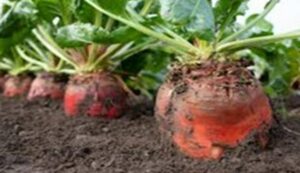Fodder Beet: ICAR developed a new variety for green fodder, farmers’ income will increase
Fodder Beet: Getting green fodder is the hardest thing for farmers in arid regions to do. Because of the erratic weather in arid regions, farmers in these places encounter several obstacles in their quest for green feed. A solution has been established by the Central Arid Zone Research Institute (ICAR) in Jodhpur, Rajasthan, after they saw the issues facing the farmers in these regions. In actuality, “fodder beet” is a fodder crop created by ICAR.

Allow us to inform you that in only four months, “fodder beet” may yield over 200 tons of green biomass per acre. Tell us everything about it in detail here in such a case.
Fodder beet: what is it?
Fodder beet is mostly used as animal feed and contributes significantly to higher milk production in cattle, which raises farmer revenue. At the moment, states like Rajasthan, Madhya Pradesh, Haryana, Chhattisgarh, Kerala, and Uttar Pradesh are cultivating it. Fodder beet is a “green fodder crop,” to put it simply.
What makes fodder beets unique?
- Soil and water of inferior quality may be used to cultivate fodder beet.
- Its prospective yield is really high.
- It increases the ability of cattle to produce milk.
- Its cultivation costs are minimal.
Better Types of Fodder Beet
- Jomon is an orange-colored beet cultivar that resists bolting and leaf disease well.
- Monroe: This reddish-purple beet type has exceptional resilience to bolting.
- JK Kuber: This orange-colored beet type is well-known for being very productive, tasty, and high in energy.
- Geronimo is a yellow-orange beet variant with high resistance to mildew-related illnesses.
How to Cultivate Fodder Beets
Soil and Climate Requirements: It may be grown in semi-arid regions since it needs a moderate temperature. This crop thrives even in low-quality water and soil.
Sowing Period: The best time to sow feeder beet is from mid-October to mid-November. Early seeding optimizes production and promotes healthy root growth.
Land Preparation: Three to four weeks before to seeding, the ground should be ploughed. Create a fine seed bed and plant seeds on ridges that are 20 cm high.
Seed Rate and Spacing: Fodder beet seeds should be planted at a rate of 2.0 to 2.5 kg/ha. Plants should be spaced 20 cm apart, with seeds planted between 2 and 4 cm of soil.
Fertilizer Management: Approximately 25 tons of FYM/ha, 100 kg nitrogen/ha, and 75 kg phosphorus/ha should be added to the soil in order to prepare it for the production of fodder beets. Three doses of nitrogen should be applied: half at sowing and half at 30- and 50-day intervals.
Techniques for Irrigation: Ten to twelve sprinkler irrigations are needed for fodder beet, using 80 to 100 cm3 of water in total. Watering need to be done every seven to ten days.
Intercultural Operations: Twenty to thirty days after sowing, you should thin, weed, and dirt up.
Pest and Disease Management: Prior to seeding, use Quinalphos powder (1.5°C) at a rate of 25 kg/ha to suppress soil-borne pests. To stop the withering of the leaves, irrigation should be done.
Harvesting: When the roots weigh between 1.0 and 1.5 kg, harvesting usually begins in the middle of January. High in nutrients, both the roots and the leaves make great animal food.
Feeding Procedures: For animal feed, chopped roots are combined with dry fodder, progressively increasing the percentage until it makes up 60% of the animal’s total intake of dry matter. For cows and buffalos, the suggested daily dose is 12 to 20 kg, and for small ruminants, it is 4 to 6 kg. Animals shouldn’t be given chopped fodder that was cut more than three days earlier or in large amounts since it might make the animals more acidic.

